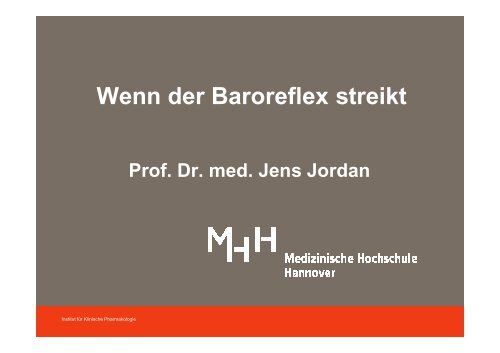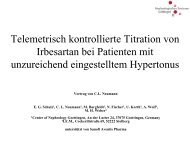Vortrag Prof. Dr. med. Jens Jordan
Vortrag Prof. Dr. med. Jens Jordan
Vortrag Prof. Dr. med. Jens Jordan
Erfolgreiche ePaper selbst erstellen
Machen Sie aus Ihren PDF Publikationen ein blätterbares Flipbook mit unserer einzigartigen Google optimierten e-Paper Software.
Wenn der Baroreflex streikt<br />
<strong>Prof</strong>. <strong>Dr</strong>. <strong>med</strong>. <strong>Jens</strong> <strong>Jordan</strong><br />
Institut für Klinische Pharmakologie
Baroreflexregulation<br />
Barorezeptoren<br />
PNS<br />
SNS<br />
Institut für Klinische Pharmakologie
Was sagt der Baroreflex dem Blutgefäß?<br />
Institut für Klinische Pharmakologie
Baroreflexregulation bei Gesunden<br />
120<br />
100<br />
Nitroprussid<br />
80<br />
60<br />
90<br />
80<br />
70<br />
60<br />
50<br />
Blood pressure [mmHg]<br />
Heart rate [beats/min]<br />
Nerve activity<br />
00:00<br />
00:10 00:20 00:30 00:40 00:50 01:00 01:10 01:20 01:30<br />
Institut für Klinische Pharmakologie
Störungen der Baroreflexregulation - Klinik<br />
Diagnostik und Therapie:<br />
• Baroreflexversagen<br />
• Autonomes Versagen<br />
• Zentral<br />
• Peripher<br />
• Posturales Tachykardiesyndrom<br />
• „Supramaximale“ vasovagale Synkopen<br />
Institut für Klinische Pharmakologie
Wenn der Baroreflex streikt<br />
• Wenn das Gehirn macht was es will<br />
• Der Hexamethonium Mann<br />
• Kann man den Baroreflex überlisten?<br />
Institut für Klinische Pharmakologie
Wenn der Baroreflex streikt<br />
Wenn das Gehirn macht was es will<br />
• Der Hexamethonium Mann<br />
• Kann man den Baroreflex überlisten?<br />
Institut für Klinische Pharmakologie
Fallbericht – Patientin 1<br />
• 54-jährige Patientin<br />
• In Vergangenheit normotensiv<br />
• Trauma im Halsbereich:<br />
• OP: Fusion C4 / C5 and C5 / C6.<br />
• Autounfall, Op: Fusion C6 / C7<br />
• Anschließend stark schwankende<br />
Blutdruckwerte<br />
• Hypertensive Phasen: 270/140 mm Hg, 120 /<br />
min<br />
• Hypotone Phasen:
Fallbericht – Patientin 1<br />
• Hypersensitivität gegenüber Arzneimitteln:<br />
• Reanimation nach Gabe von Nitroprussid<br />
• Ausgeprägte Hypotonie nach Verwendung<br />
von NTG Spray<br />
• Starker Blutdruckabfall nach niedriger Dosis<br />
Clonidin<br />
Institut für Klinische Pharmakologie
„Ruheblutdruck“ im Liegen<br />
<strong>Jordan</strong> et al. Hypertension 1997<br />
Institut für Klinische Pharmakologie
Phenylephrin Test<br />
<strong>Jordan</strong> et al. Hypertension 1997<br />
Institut für Klinische Pharmakologie
Selektives Baroreflexversagen<br />
Barorezeptoren<br />
PNS<br />
SNS<br />
Institut für Klinische Pharmakologie
Nichtselektives Baroreflexversagen<br />
Barorezeptoren<br />
PNS<br />
SNS<br />
Institut für Klinische Pharmakologie
Baroreflexversagen - 24-h Blutdruck<br />
250<br />
30 min<br />
200<br />
213<br />
ABD [mm Hg]<br />
HF [min<br />
-1 ]<br />
150<br />
100<br />
98<br />
110<br />
116<br />
50<br />
55<br />
0<br />
09:00 12:00 15:00 18:00 21:00 00:00 03:00 06:00 09:00<br />
Institut für Klinische Pharmakologie
Ursachen von Baroreflexversagen<br />
Halstrauma<br />
– Operationen<br />
– Unfälle<br />
– Strahlentherapie<br />
Neuropathie?<br />
Institut für Klinische Pharmakologie
Baroreflexversagen - Therapie<br />
Akut<br />
Sedierung<br />
Akut+chronisch<br />
Sympatholytika<br />
Schrittmacher<br />
Blutdrucksteigernde Medikamente<br />
Barorezeptoren<br />
PNS<br />
SNS<br />
Institut für Klinische Pharmakologie
Wenn der Baroreflex streikt<br />
• Wenn das Gehirn macht was es will<br />
Der Hexamethonium Mann<br />
• Kann man den Baroreflex überlisten?<br />
Institut für Klinische Pharmakologie
Autonomes Versagen<br />
Barorezeptoren<br />
PNS<br />
SNS<br />
Institut für Klinische Pharmakologie
Pharmakologische Ganglienblockade<br />
Parasympathikus<br />
Sympathikus<br />
Ganglien<br />
ACh<br />
ACh<br />
ACh<br />
Hexamethonium<br />
Pentolinium<br />
Trimetaphan<br />
Endorgan ACh Noradrenalin ACh<br />
Adrenalin<br />
Institut für Klinische Pharmakologie
Paton’s Hexamethonium Man (Auszug)<br />
“He is a pink complexioned person, except when he has stood for a<br />
long time, when he may get pale and faint. His handshake is warm<br />
and dry. He is thin because his appetite is modest; he never feels<br />
hunger pains and his stomach never rumbles. As old age comes on<br />
he will suffer from retention of urine and impotence but frequency,<br />
precipitancy, and strangury will not worry him. One is uncertain how<br />
he will end, but perhaps if he is not careful, by eating less and less<br />
and getting colder and colder, he will sink into a symptomless,<br />
hypoglycemic coma and die, as was proposed for the universe, a<br />
sort of entropy death.“<br />
Paton WDM. Pharmacol Rev. 1954;6:59-67<br />
Institut für Klinische Pharmakologie
Ganglienblockade bei Gesunden<br />
Systolischer Blutdruck (mm Hg)<br />
140<br />
120<br />
100<br />
80<br />
60<br />
ohne GB<br />
mit GB<br />
0 10 20 30 40 50 60 70<br />
Kipptischwinkel (°)<br />
<strong>Jordan</strong> et al. Hypertension 1998<br />
Institut für Klinische Pharmakologie
Der Hexamethonium-Mann<br />
Anamnese:<br />
43 jähriger Mann<br />
Rezidivierende orthostatische Synkopen seit >20 Jahren<br />
Anhidrose, Xerostomie, Völlegefühl, Obstipation<br />
Körperliche Untersuchung:<br />
Warme und trockene Haut<br />
Konnte nicht stehen, orthostatische Hypotonie<br />
Tonische Pupillen<br />
Weitergehende Untersuchungen:<br />
Stark verlangsamte gastrointestinale Passage<br />
Flache Herzfrequenzkurve<br />
Noradrenalin im Plasma stark reduziert<br />
Institut für Klinische Pharmakologie
Institut für Klinische Pharmakologie<br />
„…his stomach never rumbles”
Patientenantikörper blockieren ACh Wirkung<br />
AK Konzentration beim<br />
Patienten: 0.54 nM<br />
Schroeder et al. N Engl J Med 2005<br />
Institut für Klinische Pharmakologie
Stehversuch<br />
vorher<br />
nachher<br />
180<br />
BP<br />
mmHg<br />
0<br />
100<br />
HR<br />
bpm<br />
40<br />
0 Seconds<br />
240 0<br />
Seconds 240<br />
Schroeder et al. N Engl J Med 2005<br />
Institut für Klinische Pharmakologie
vorher<br />
Handgrip Test<br />
nachher<br />
180 Blutdruck<br />
mmHg<br />
0<br />
100<br />
Herzfrequenz<br />
bpm<br />
40<br />
0 Sekunden<br />
300 0<br />
Sekunden 300<br />
Institut für Klinische Pharmakologie
Orthostatische Hypotonie und Antikörper<br />
0.6<br />
nACh AB [nmol/L]<br />
0.4<br />
0.2<br />
0.0<br />
0<br />
∆SBP [mmHg]<br />
-25<br />
-50<br />
-75<br />
-100<br />
0 1 2 3<br />
time [months]<br />
12<br />
Schroeder et al. N Engl J Med 2005<br />
Institut für Klinische Pharmakologie
Differentialdiagnose<br />
Sekundäre autonome Neuropathie?<br />
– Diabetes mellitus<br />
– Paraneoplastisch<br />
– Autoimmun<br />
– Amyloidose<br />
– Medikamente…<br />
“Primäres” autonomes Versagen<br />
– Multisystematrophie<br />
– Bradbury-Eggleston Syndrom (PAF)<br />
– Genetische Erkrankungen (z.B. DBHD)<br />
Institut für Klinische Pharmakologie
Therapie<br />
• In der Regel keine kausale Therapie bekannt<br />
• Therapie der orthostatischen Hypotonie<br />
• Therapie der nächtlichen Hypertonie<br />
• Therapie anderer vegetativer Symptome<br />
Institut für Klinische Pharmakologie
Wassertrinken – Peripheres Autonomes Versagen<br />
50<br />
Pure Autonomic Failure<br />
∆ mm mmHg Hg<br />
oder or bpm<br />
1/min<br />
40<br />
30<br />
20<br />
10<br />
0<br />
-10<br />
n=19<br />
SBP<br />
DBP<br />
HR<br />
-10 0 10 20 30 40 50 60<br />
480 ml Wasser<br />
Zeit (Minuten)<br />
time (min)<br />
<strong>Jordan</strong> et al. Lancet 1999, Circulation 2000<br />
Institut für Klinische Pharmakologie
Manöver zur Blutdruckstabilisierung<br />
Wieling W. et al. Nonpharmacological treatment of reflex syncope. CAR 2004 (14):I/62-I/70.<br />
Institut für Klinische Pharmakologie
Blutdrucksteigernde Arzneimittel<br />
Indomethacin 50mg<br />
45<br />
30<br />
n=18<br />
∆SBP<br />
15<br />
(mmHg)<br />
0<br />
-15<br />
0 20 40 60 80 100 120<br />
Zeit (min)<br />
<strong>Jordan</strong> et al. Am J Med 1998<br />
Institut für Klinische Pharmakologie
Autonomes Versagen - Hypertonie im Liegen<br />
Blutdrucksenkung<br />
durch Ganglienblockade<br />
PAF = periphere Neuropathie<br />
MSA = zentrale Neuropathie<br />
Shannon JR et al. Hypertension 1997<br />
Shannon JR et al. Circulation 2000<br />
Institut für Klinische Pharmakologie
Ziegelstein unterm Bett oder Kipptisch…<br />
82 /min 86 /min<br />
HF<br />
Liegen<br />
188/102<br />
mm Hg<br />
HUT +15°<br />
129/83<br />
mm Hg<br />
BD<br />
Institut für Klinische Pharmakologie
Ziegelstein unterm Bett oder Kipptisch…<br />
Institut für Klinische Pharmakologie
Antihypertensiva bei Hypertonie im Liegen?<br />
Nitroglyzerinpflaster in niedriger Dosis<br />
<strong>Jordan</strong> et al. JASN 1999<br />
Institut für Klinische Pharmakologie
Wenn der Baroreflex streikt<br />
• Wenn das Gehirn macht was es will<br />
• Der Hexamethonium Mann<br />
Kann man den Baroreflex überlisten?<br />
Institut für Klinische Pharmakologie
Institut für Klinische Pharmakologie<br />
Baroreflexschrittmacher
Institut für Klinische Pharmakologie<br />
Baroreflexschrittmacher
DEBUT Ht Studie<br />
• 45 Patienten mit therapierefraktärer Hypertonie<br />
• Keine Kontrollgruppe<br />
Scheffers IJ et al. J Am Coll Cardiol 2010<br />
Institut für Klinische Pharmakologie
Substudie von DEBUT Ht<br />
Number/gender<br />
Age [years]<br />
BMI [kg/m²]<br />
SAP [mmHg]<br />
DAP [mmHg]<br />
HR [bpm]<br />
mean±SEM<br />
12 / 7 m 5 w<br />
58 ± 2.6<br />
31 ± 2.1<br />
193 ± 8.7<br />
94 ± 5.1<br />
73 ± 3.9<br />
range<br />
43 - 70<br />
22 - 49<br />
132 - 232<br />
65 - 126<br />
58 - 97<br />
Institut für Klinische Pharmakologie
217/120<br />
167/95<br />
Heusser K et al. Hypertension 2010; 55:619-26<br />
Institut für Klinische Pharmakologie
Institut für Klinische Pharmakologie<br />
Heusser K et al. Hypertension 2010; 55:619-26
Sympatholytische Wirkung und Blutdrucksenkung<br />
Sympathische Nervenaktivität<br />
Plasma Noradrenalin<br />
Heusser K et al. Hypertension 2010, 55:619-26<br />
Institut für Klinische Pharmakologie
Ist physiologische Baroreflexfunktion intakt?<br />
Cross spectral<br />
analysis<br />
Sequence<br />
technique<br />
Heusser K et al. Hypertension 2010, 55:619-26<br />
Institut für Klinische Pharmakologie
Baroreflex und Hypertensiologie<br />
Prognostischer Marker<br />
Mechanismus für Hypertonie<br />
Zielstruktur für Therapie<br />
Barorezeptoren<br />
PNS<br />
SNS<br />
Institut für Klinische Pharmakologie



